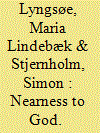| Srl | Item |
| 1 |
ID:
188961


|
|
|
|
|
| Summary/Abstract |
This article advocates for an increased attention to how piously striving Muslims learn about, cultivate, and experience nearness to God. The empirical material is taken from our current research on Danish Muslims’ engagement with Islamic teaching and learning. We examine examples of oral teachings that instruct the audience to be constantly aware of God and address him directly in prayer, examples of how an awareness of God is cultivated and practiced in everyday life, and individual narratives of experiences of being close to or helped by God. With inspiration from the anthropology of Christianity as well as Islam, we propose an analytical model for understanding the process whereby Muslim efforts to draw near to God can ‘work’. Three interrelated dynamics are crucial to this process, and we identify each through our reading of existing scholarship. The dynamics at play are, respectively, a taqwa-infused faith frame, its related semiotic ideology, and a relationship of experienced reciprocal agency with God.
|
|
|
|
|
|
|
|
|
|
|
|
|
|
|
|
| 2 |
ID:
144556


|
|
|
|
|
| Summary/Abstract |
Govardhanram Tripathi wrote the four-volume novel Saraswatichandra as an ‘instruction manual’ for a people facing fundamental social and political change during colonial rule. This article examines a shift in the conception of instruction as the text progressed through its instalments—from a notion of learning as a process of deliberation about, and experimentation with, imitable actions, to the idea of education through the representation of action—a transformation that is made conspicuous by the discordance between the widely debated and highly influential initial volumes and the largely ignored final volume. It situates this shift in broader changes in the idea of instruction in Indian society, and investigates it in order to better understand the strains involved in attempting to codify or theorize certain types of domains.
|
|
|
|
|
|
|
|
|
|
|
|
|
|
|
|